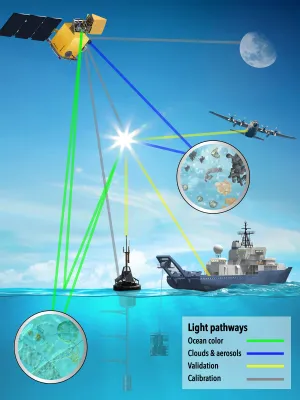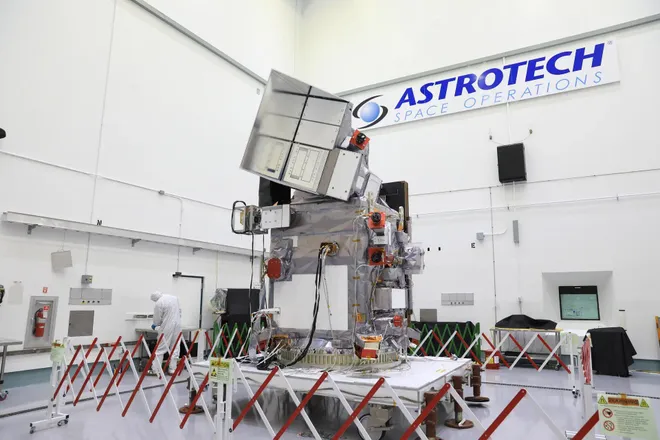A new satellite could help scientists unravel some of Earth's mysteries. Here's how.
Imagine coloring a picture with 200 crayons instead of eight.
That’s the difference in light and color that a new satellite bound for orbit will bring to the study of microscopic particles in our atmosphere and waterways, said Jeremy Werdell, a project scientist with the National Aeronautic and Space Administration.
The satellite – called the Plankton, Aerosol, Cloud and Ocean Ecosystem, or PACE – will provide critical new information to help better understand the role such particles play in the exchange of carbon dioxide and energy in the atmosphere and ocean, and in our changing climate, scientists said.
By returning high resolution images of light wavelengths, its equipment will provide a first-of-its-kind look at the role of phytoplankton in oceans, lakes and rivers and how aerosols absorb and scatter the sun’s energy, the scientists said.
More than a decade in the making, the satellite will relay this information in a broader array of colors than ever before, allowing scientists to identify individual species of plankton and kinds of particles.
As the expected launch date – Feb. 6 – approaches, excitement is building not only among the project’s scientists and developers, but also among scientists who look forward to using the new information in their research. The satellite will launch from the Cape Canaveral Space Force Station, aboard a SpaceX Falcon 9.

Unraveling mysteries
Information collected by the three instruments aboard could be crucial to unraveling some of Earth’s most complex climate mysteries, at a critical point when the planet is undergoing “transformative change,” said Pam Melroy, NASA’s deputy administrator.
“We are undeniably in the midst of a climate crisis,” Melroy said. “Shifts in the global Earth system, including climate change, are accelerating and the impacts are growing in both frequency and intensity.”
One of the key factors in the changing climate is the role of carbon and heat energy in the ocean.
Scientists hope to learn more about where carbon in the ocean is going, and if it’s being permanently removed from the atmosphere, and PACE will answer those questions on a daily global scale, the scientists said. It will also measure aerosols and help address questions about the life and precipitation intensity of clouds.
With a total mission budget of $964 million, the three instruments on board include an optical spectrometer designed and built by NASA and two other polarimeters, one from the University of Maryland and one from a consortium of organizations in the Netherlands.

Advancing ocean science
“For those of us who study microscopic life in the ocean, it is incredibly exciting that NASA’s PACE mission is going to launch in a few weeks,” said Heidi Sosik, a senior scientist in biology, whose research interest focus on phytoplankton ecology and factors that influence light in marine environments.
The array will give scientists “a whole new way to detect patterns of change in phytoplankton,” she said. The data it collects will help scientists understand changes in marine systems, manage fisheries, protect threatened species and ensure human food supplies are free from toxins. NASA said the data will be open and available to all scientists.
The spectrometer's ability to measure light across portions of the electromagnetic spectrum, at finer resolution than previous sensors, represents “a major advancement" in monitoring ocean ecosystems in the open ocean, said Tom Bell, an assistant scientist in applied ocean physics and engineering at Woods Hole Oceanographic Institution.
Just like plants convert carbon dioxide, phytoplankton uses photosynthetic pigments in its cells to collect light.
PACE will help scientists see the different colors and identify phytoplankton species and differentiate them from other dissolved materials in the water. That’s important because each phytoplankton community may play different roles in ecosystems and food chains.
The equipment also may allow Woods Hole researchers to examine the relationship between coastal runoff and the blooms of sargassum that have been choking coastlines in the Caribbean and Southeastern U.S. for years, said Bell, who uses satellite imagery to study coastal waters and their ecosystems.
The polarimeters will examine the composition, movement and interaction of particles of sea salt, smoke, pollutants and dust, a group collectively called aerosols, by measuring light properties.
The information is expected to help scientists make better climate predictions, by revealing how aerosols in the atmosphere interact with greenhouse gases and reflect sunlight back to space, said Otto Hasekamp, an atmospheric scientist with the Netherlands Institute for Space Research.
The instruments also will look at air and water quality after disasters, including hurricanes and wildfires, and help scientists understand the cascading impacts, said Karen St. Germaine, earth science division director for NASA. “It’s going to greatly advance and add to our understanding of ocean biology and the relationship between ocean life and our atmosphere."
Disclaimer: The copyright of this article belongs to the original author. Reposting this article is solely for the purpose of information dissemination and does not constitute any investment advice. If there is any infringement, please contact us immediately. We will make corrections or deletions as necessary. Thank you.







